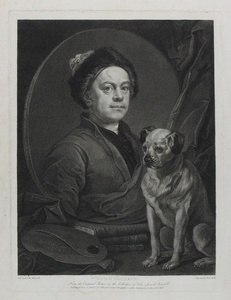| Method | Stipple |
| Artist | Benjamin Smith after William Hogarth |
| Published | Published June 4, 1795, by J & J Boydell, No 90 Cheapside, & at the Shakspeare Gallery Pall Mall |
| Dimensions | Image 357 x 278 mm, Plate 394 x 301 mm, Sheet 645 x 470 mm |
| Notes |
A portrait of William Hogarth, after the self portrait in oil now in the collections of the Tate. Hogarth is depicted half length on an oval canvas, wearing fur-lined montero cap and a painter's smock. The canvas rests on a stack of three books: Shakespeare, Swift, and Milton. In the foreground is an artist's palette featuring Hogarth's 'Line of Beauty and Grace' and the artist's initials with the date '1745.' To the right of the canvas is Trump, the best known of Hogarth's pugs, and likely the model for the pug featured in Plate 5 of Hogarth's celebrated Rake's Progress. Recent investigation has indicated that Trump was a later addition to the original oil painting, and that the artist had initially depicted himself in full wig, surcoat, and cravat. This portrait was originally used by the artist as a frontispiece for bound publications of his prints, and was subsequently used as the model for the artist in Hogarth Painting the Comic Muse. The latter replaced this portrait as frontispiece in editions of Hogarth's works published after 1759. In 1763, the plate was revised and reprinted as 'The Bruiser,' a biting satire of Charles Churchill in retaliation for Churchill's critical Epistle to William Hogarth. Benjamin Smith (1754-1833) was a British engraver, printseller, and publisher. A student of Francesco Bartolozzi, his most celebrated engravings were the series he undertook for Boydell's editions of Shakespeare and Milton, though he also produced many fine plates after William Hogarth and George Romney, as well as portraits of George III. William Hogarth (1697 - 1764) was born in London, the son of an unsuccessful schoolmaster and writer from Westmoreland. After apprenticeship to a goldsmith, he began to produce his own engraved designs in about 1710. He later took up oil painting, starting with small portrait groups called conversation pieces. He went on to create a series of paintings satirising contemporary customs, but based on earlier Italian prints, of which the first was The Harlot's Progress (1731), and perhaps the most famous The Rake's Progress. His engravings were so plagiarised that he lobbied for the Copyright Act of 1735, commonly referred to as 'Hogarth's Act,' as a protection for writers and artists. During the 1730s Hogarth also developed into an original painter of life-sized portraits, and created the first of several history paintings in the grand manner. Paulson 181, Copy in reverse. Condition: Water stain to bottom half of sheet, water stain to text area below image, time toning and foxing to sheet. |
| Framing | unmounted |
| Price | £180.00 |
| Stock ID | 48285 |

